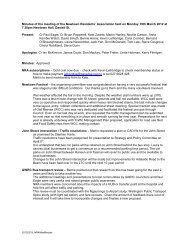Draft Town Belt Management Plan - Wellington City Council
Draft Town Belt Management Plan - Wellington City Council
Draft Town Belt Management Plan - Wellington City Council
Create successful ePaper yourself
Turn your PDF publications into a flip-book with our unique Google optimized e-Paper software.
Powers to grant easements: The <strong>Council</strong> may grant rights of way and other easements over the<br />
<strong>Town</strong> <strong>Belt</strong> in accordance with section 48 of the Reserves Act 1977.<br />
Powers to grant licences: The <strong>Council</strong> may grant licences to use parts of the <strong>Town</strong> <strong>Belt</strong> in<br />
accordance with section 54 of the Reserves Act 1977.<br />
2.4 <strong>Town</strong> <strong>Belt</strong> alienations<br />
The Crown (latterly through the Superintendent of the Province of <strong>Wellington</strong>) held the <strong>Town</strong> <strong>Belt</strong><br />
from 1841 to 1871 and, despite instructions from the New Zealand Company that the land was not to<br />
be built upon, one third of the original <strong>Town</strong> <strong>Belt</strong> (around 195 ha) was alienated and developed for<br />
community and social welfare purposes. For example, land for the McCleverty Awards, hospital,<br />
‘lunatic’ and educational purposes, and the Mt Victoria signal station. These alienations and others<br />
after 1871 are described below.<br />
The alienations were well intended in response to community pressures and problems. The perceived<br />
value of the <strong>Town</strong> <strong>Belt</strong>’s continuous open space was considered much less than the need to find<br />
affordable land for community facilities. Consequently, the size, continuity and shape of the original<br />
<strong>Town</strong> <strong>Belt</strong> changed significantly (see the map of original <strong>Town</strong> <strong>Belt</strong> on page 3).<br />
The first alienations took place in 1847 with the McCleverty Awards that allocated around 200 acres<br />
(80.94ha) of the 1544 acres to Maori in recompense for settlers occupying Maori land in Thorndon.<br />
The 200 acres now comprises the “Ex-Telecom” land on Te Ahumairangi Hill and land that has<br />
subsequently been developed for residential housing in Northland, Thorndon, Kelburn, Aro Valley,<br />
Brooklyn and Vogeltown. The remaining land was approximately 1344 acres (543.9ha).<br />
In 1861, of the 1344 acres, 1234 acres (499.4ha) was granted by the Crown to the Superintendent of<br />
<strong>Wellington</strong> Province to be held “in trust for the purposes of public utility of the <strong>Town</strong> of<br />
<strong>Wellington</strong>...” The 100 acre shortfall appears to include land at and around the Basin Reserve and<br />
land allocated for Wesleyan Reserve of which parts are part of the <strong>Wellington</strong> Botanic Garden.<br />
In 1872, the Superintendent allocated a total of at least 166 acres (67.18ha) of the 1234 acres for<br />
public utility purposes. This comprised 143 acres (57.87ha) for college purposes and a lunatic asylum.<br />
This land is now occupied by <strong>Wellington</strong> Hospital, the ‘Ex-Chest Hospital’ land off Alexandra Road,<br />
<strong>Wellington</strong> College, <strong>Wellington</strong> East Girls College and the Vice Regal property. The Superintendent<br />
also allocated 18 acres (7.28ha) at Clifton Terrace for general hospital purposes and 5 acres (2.02ha)<br />
at the top of Mt Victoria for a signal station.<br />
The purposes of community health, education and communication fall within the wide meaning of<br />
the phrase public utility, and accordingly are legally authorised in terms of the 1861 grant. The 166<br />
acres was never subject to legal protection of the more narrow purpose of public recreation ground<br />
under the 1873 deed.<br />
In 1873, only 1061 acres (429 hectares) was finally conveyed to the <strong>Wellington</strong> <strong>City</strong> <strong>Council</strong> on trust<br />
to be forever used as “public recreation ground for the inhabitants of the <strong>City</strong> of <strong>Wellington</strong>”. It is<br />
only this land that has been subject to trust for <strong>Town</strong> <strong>Belt</strong> reserve purposes. Since 1873, and contrary<br />
to the trust, land has been removed from the <strong>Town</strong> <strong>Belt</strong> by the Crown and/or the <strong>City</strong> <strong>Council</strong>. To do<br />
this requires legislative change. Since 1873, there have been the following alienations:<br />
16<br />
• land occupied by Victoria University<br />
• land off Colville/Paeroa streets in Newtown<br />
• ex-tram depot, now <strong>Council</strong> housing in Mansfield Street, Newtown<br />
• electricity substation on Nairn Street<br />
• Te Aro School land, Abel Smith Street<br />
• ex-fire brigade land at the top of Constable Street<br />
• land for roads as the city expanded.<br />
<strong>Draft</strong> <strong>Town</strong> <strong>Belt</strong> <strong>Management</strong> <strong>Plan</strong> October 2012





